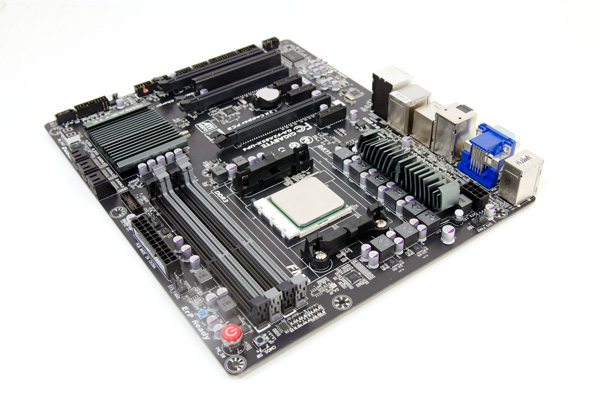AMD A10-5800K & A8-5600K Review: Trinity on the Desktop, Part 1
by Anand Lal Shimpi on September 27, 2012 12:00 AM ESTFinal Words
On average, Trinity's high-end 384-core GPU manages to be around 16% faster than the fastest Llano GPU, while consuming around 7% more power when active. Given that Trinity is built on the same process node at Llano, I'd call that a relatively good step forward for AMD's equivalent of a "tick". From AMD's perspective, the fact that it can continue to deliver a tangible GPU performance advantage over Intel's latest and greatest even with its die harvested APU (256-core Trinity) is good news. For anyone looking to build a good entry level gaming PC, the Trinity platform easily delivers the best processor graphics performance on the market today. If you're able to spend an extra $100 on a discrete GPU you'll get better performance, but below that Trinity rules. The trick, as always, will be selling the GPU performance advantage alongside the presumably lower x86 CPU performance. We'll have to wait another week to find out the full story on that of course, but if you're mostly concerned about GPU gaming performance, Trinity delivers.
Ivy Bridge was a good step forward for Intel, the problem is that only the high-end Ivy Bridge graphics configuration borders on acceptable. The HD 2500's performance is really bad unfortunately. It's easy to appreciate how far Intel has come when we look at improvements from one generation to the next, but when you start running benchmarks on Trinity it really compresses the progress Intel has made. When Haswell shows up it may be a different game entirely, but until then if you're interested in a platform with processor graphics (with an emphasis on the graphics part), Trinity is as good as it gets.











139 Comments
View All Comments
leexgx - Saturday, October 6, 2012 - link
T** Hardware i have made sure i never goto there web site again (even saying there website name as google counts that towards stats)most stuff on there cant be trusted
blackmagnum - Thursday, September 27, 2012 - link
I hope AMD aim their products for first place in the best price/ performance race with Intel. This seems the only way they will be bought other than for the health of competition or nostalgic sense of pity.duploxxx - Thursday, September 27, 2012 - link
pity for what? do you really think you need more CPU perfromance then a Piledriver core deliver? Do you really think that the Trinity isn't good enough power consumption wise.Its fools who believe they need an i7 to run daily desktop usage. spend the wasted money of an i7 on a fast disc (SSD) and your overall platform experience and performance will be much higher then your so called fixed brand name.
daos - Thursday, September 27, 2012 - link
are you serious? people use computers for more than "daily desktop usage". Video editing, graphics design, multi-threaded apps, benchmarking, even gaming...Every bit counts the larger the scale. CPUs can make a huge difference in all of the above mentioned except for maybe gaming unless at an enormous resolution like I am.
And you have to remember that everything is relative. You are concerned with wasting your money whereas the next guy could care less about an extra 2 or 3 hundred dollars for the best. Thats a drop in the bucket for him. Hell, thousands more can be a drop in the bucket if the best is what your after...its simple. Go Intel.
dagamer34 - Thursday, September 27, 2012 - link
When the average selling price of a computer is $450 in the US, I don't see how that really includes any of the things you listed above.Alexvrb - Thursday, September 27, 2012 - link
Heck, for most people, a Tegra 3 or similar in a tablet is enough computing power. A lot of people just stroll into a store and buy the advertised on-sale laptop for $300-400. For these people an APU might not be a bad choice, given that the lower-end Intel chips all have horribly crippled GPUs.lwatcdr - Thursday, September 27, 2012 - link
"Video editing, graphics design, multi-threaded apps, benchmarking, even gaming..."Some do but more and more of those tasks really benifit from a GPU boost. Most Adobe products now use openCL so they can take advantage of the GPU. That will cover Video editing, graphics design and gaming. multi-trheaded apps benifit more form core count than raw cpu and most multi-threaded apps will do just fine on th A10.
Benchmarking? Really that is called a hobby unless you are doing it to test systems for a living. You do not buy hardware just to bet a higher benchmark score you Benchmark hardware to find the cheapest way to get a task done in a reasonable amount of time. Anything else is a hobby and while that is all fine and good it is a tiny fringe element of a fraction of a percentage of the PC market.
Denithor - Thursday, September 27, 2012 - link
But this is the desktop market. It's simply too easy to install a discrete GPU that is tons faster than any iGPU, even this new Trinity. Integrated GPU just doesn't cut it for most of those applications.Maybe for an HTPC. But that's honestly the only place I'd even consider pointing anyone toward an APU over a CPU+GPU.
chrnochime - Thursday, September 27, 2012 - link
There are always people who make stupid blanket statements like yours. "People" would mean everyone. You not writing "some" in there basically means you think everyone think the way you do. If that were not the case your sentence would not have been written that way.Don't like my nitpicking? Don't write stupid blanket statements then.
mikato - Monday, October 1, 2012 - link
what do you mean "you people"?